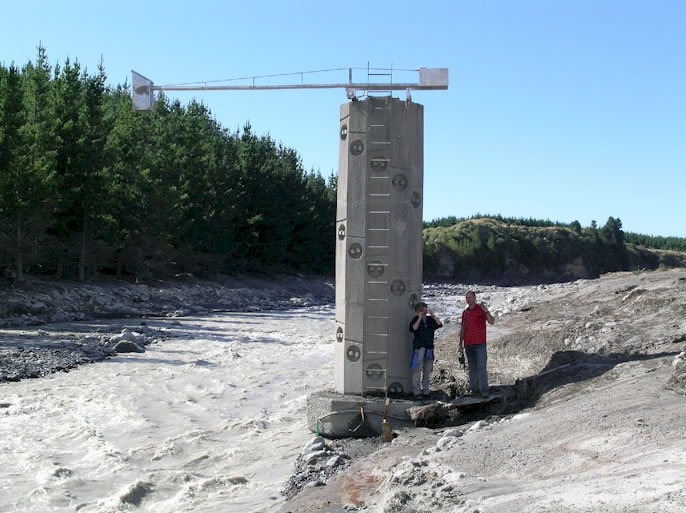



長年の努力が実を結びました。私たちは
世界クラスのデータセットを収集し、
この火山泥流はこれまでで最もよく研究された泥流となるでしょう。—
バーン・マンビル博士、GNS Science
マンビル博士の言葉は、ラハールと呼ばれる火山の岩盤崩落と泥流に関する独自の研究の成功を物語っています。火山の火口が雨水で満たされると、火口の壁が崩れ、泥と岩の壊滅的な洪水が流れ出すことがあります。ラハールという言葉はインドネシアのジャワ島に由来しており、そこでは火山の頻繁な活動と雨の多さから、こうした泥流が頻繁に発生します。ラハールは、発生が予測できず、流れが激しいため、研究するのが難しいのが普通です。
いつ、どこに機器を設置するかは難しい判断です。岩石が詰まった高密度の火山泥流は、その進路にある機器を損傷したり破壊したりすることがよくあるからです。このため、ニュージーランドのGNS科学機関とマッシー大学のマンビル博士と彼のチームは、ルアペフ山のクレーター湖で最近発生した大規模な火山泥流の前に監視機器を設置できたことは、まれに見る幸運だと考えました。火山は研究センターに十分近かったため、現場で徹底的な準備を行うことができました。予想される流れの進路は十分に予測可能だったため、センサーを破壊されずに最大限の情報を収集できる場所に設置することができました。
Campbell Scientific の機器は、この作業で大きな役割を果たしました。CR1000 データロガーに接続された CC640 デジタル カメラは、火口壁の劇的な崩壊と、開口部から湖水があふれ出る様子を捉えました。センサーと CR1000 および CR800 データロガーは、ラハールの進路に沿って配置され、そのレベルと堆積物の内容に関するデータを収集しました。機器は、ラハールの強大な力に耐えられるように、強化された塔や峡谷の壁に設置する必要がありました。
マンビル博士は「装置は完璧に機能し、天候もダムの崩壊とクレーター湖の水が破裂して流れ出るのを見るのにちょうど良いくらい良好でした」と語りました。科学者たちは追跡データの収集に数か月、そしてそのすべてを分析するのに何年も費やすことになります。ニュージーランドのルアペフ火山泥流の徹底的な研究により、こうした危険な現象をより正確に予測し、備えることができるようになるかもしれません。
ケーススタディの概要
アプリケーション
火山灰ダム決壊後の火山火口湖からのラハール泥流の監視場所
ニュージーランド使用製品
CC640 CR800 CR1000寄稿者
Roger HardyScott Technical Instruments参加団体
GNS Science計測項目
ダム破壊のビデオ録画、バブラーユニットで測定された火口湖の水位、レーダーと圧力トランスデューサーで測定された流量レベル関連ウェブサイト
Lahar images参加コンサルタント/インテグレーター
Scott Technical Instruments Ltd.PDFで見る